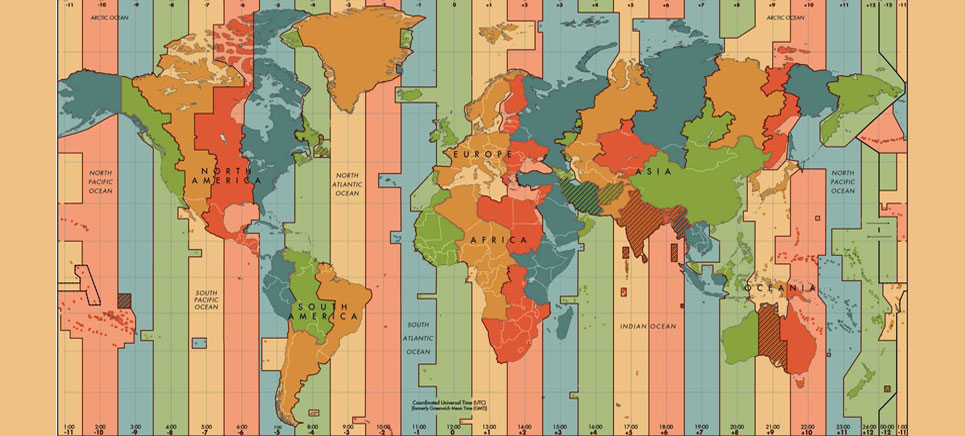Imagine, you are traveling from London (United Kingdom) to Tokyo (Japan). As your flight gets down in Tokyo, you will have to forward your watch by eight hours. This addition of 8 hours is due to the change in time zones. London follows British Summer Time which is one hour ahead of the Universal Coordinated Time (UTC) while Tokyo follows Japan Standard Time which is 9 hours ahead of the UTC. Thus, if you do not adjust your watch after landing in Tokyo, you will be 8 hours behind the current time of Tokyo. This entire concept of time conversion is based on time zones.
Different places on planet Earth witness different portions of the day at one particular time. When it’s midnight in Capetown (South Africa), Honolulu (United States) experiences noon of the previous day. This is because of Earth’s rotation on its axis. Thus, the terrestrial globe of Earth has been divided into time zones to avoid any time-related conflicts or confusion.
What are the Time Zones?
Time Zones are a geographical division of the terrestrial globe into 24 longitudinal sections. The distance between two consecutive time zones is approximately 15°. Each such time zone observes a uniform standard time.
Why do countries need different time zones?
Maintaining different time zones for any country is not an easy choice. From commercial and business transactions to transportation and communication, everything is dependent on time. Thus, most countries of the world have opted for one standard time zone. Some countries, with comparatively larger areas or territories scattered around the world, do opt for multiple time zones. For example, the USA, Russia and Canada have multiple time zones within the country.

Which country has the most time zones in the world?
This question needs to ideally be answered in two different ways.
- Country with most number of time zones – France (12 time zones)
- Country with most number of time zones in mainland – Russia (11 time zones)
Explanation: It is true that overall France has the most number of time zones falling under its territories. Nevertheless, there is only one time zone in France’s mainland territory and the rest 11 time zones belong to its territories scattered all across the world. On the other hand, Russia is divided into 11 time zones consecutively.
Time zone example: USA
In order to understand the time zone difference in a country, let’s take the example of the United States. The USA is divided into 9 time zones as per law. This covers mainland USA and its dependencies.
- Florida, Ohio, or New York have Eastern Daylight Time (UTC-4)
- Texas has Central Daylight Time (UTC-5)
- Salt Lake City has Mountain Daylight Time (UTC-6)
- Los Angeles comes under Pacific Daylight Time (UTC-7)
- Arizona is in the Mountain Standard Time (UTC-7)
- Anchorage is under the Alaska Daylight Time (UTC-8)
- Honolulu has Hawaii Standard Time (UTC-10)
UTC or Coordinated Universal Time
Coordinated Universal Time or UTC, is the primary time standard that regulates time around the world. All the timing centers of the world synchronize or coordinate their time scales in accordance with the UTC. This is the reason why it is called Coordinated Universal Time.
There are two components that determine the UTC, namely International Atomic Time and Universal Time. International Atomic Time is a high precision atomic coordinate time standard. This time scale combines the output of around 400 high-precision atomic clocks worldwide. Universal Time, on the other hand, refers to a more traditional time calculation method – the rotation of the Earth. It compares the actual length of the day with the time pace provided by the International Atomic Time.
What is UTC Offset?
UTC Offset is the time difference of a particular place from UTC. It is measured in hours and minutes.
Format of writing UTC Offset
UTC offset is written mainly in three formats:
- ±[hh]:[mm]
- ±[hh][mm]
- ±[hh]
For a place ahead of UTC (east of UTC), a positive sign is used. Similarly, for a place which is located behind the UTC (west of UTC), a negative sign is used.
Example
The time zone in Toronto (Canada) is UTC-4 while the time zone in Beijing (China) is UTC+8.
What is GMT?
GMT stands for Greenwich Mean Time. It is the solar time or clock time at the Royal Observatory in Greenwich, an area in South East London. It is the predecessor of Coordinated Universal Time that was adopted in 1967. In present times, it is considered equivalent to UT1 for navigation purposes. UT1 is the modern form of mean solar time at zero degrees longitude.
What is the difference between GMT and UTC?
Practically there lies no difference between GMT & UTC. However, there lie two main technical differences between the GMT and the UTC.
- There lies an extremely minuscule time difference of 0.9 seconds between the Coordinated Universal Time (UTC) and Greenwich Mean Time(GMT). This is the reason why GMT is referred to as the UT1 time zone and not UTC.
- GMT is a time zone while UTC is a primary time standard and not a time zone. GMT is accordingly used by many countries of Europe and Africa as a time zone while the same is no so for UTC.
Use the citation below to add this article to your bibliography
"Time Zones of the Earth: Map and How to do Calculation." Dashamlav.com. Web. 13 June 2025. <https://dashamlav.com/time-zones-map-earth-definition-calculation/>
Dashamlav.com, "Time Zones of the Earth: Map and How to do Calculation." Accessed 13 June 2025. https://dashamlav.com/time-zones-map-earth-definition-calculation/
"Time Zones of the Earth: Map and How to do Calculation." (n.d.). Dashamlav.com. Retrieved 13 June 2025 from https://dashamlav.com/time-zones-map-earth-definition-calculation/
